Avoid getting scammed by the fake "DHL Undelivered Package" email
Phishing/ScamAlso Known As: DHL Undelivered Package spam
Get free scan and check if your device is infected.
Remove it nowTo use full-featured product, you have to purchase a license for Combo Cleaner. Seven days free trial available. Combo Cleaner is owned and operated by RCS LT, the parent company of PCRisk.com.
What is "DHL Undelivered Package email scam"?
"DHL Undelivered Package email scam" refers to a spam campaign. These letters are disguised as notifications concerning an undelivered package from DHL. It must be emphasized that these scam emails are in no way related to the genuine international courier, package delivery, and mail service provider.
This spam mail aims to generate revenue at user expense. Hence, by trusting these emails - recipients can experience various severe issues.
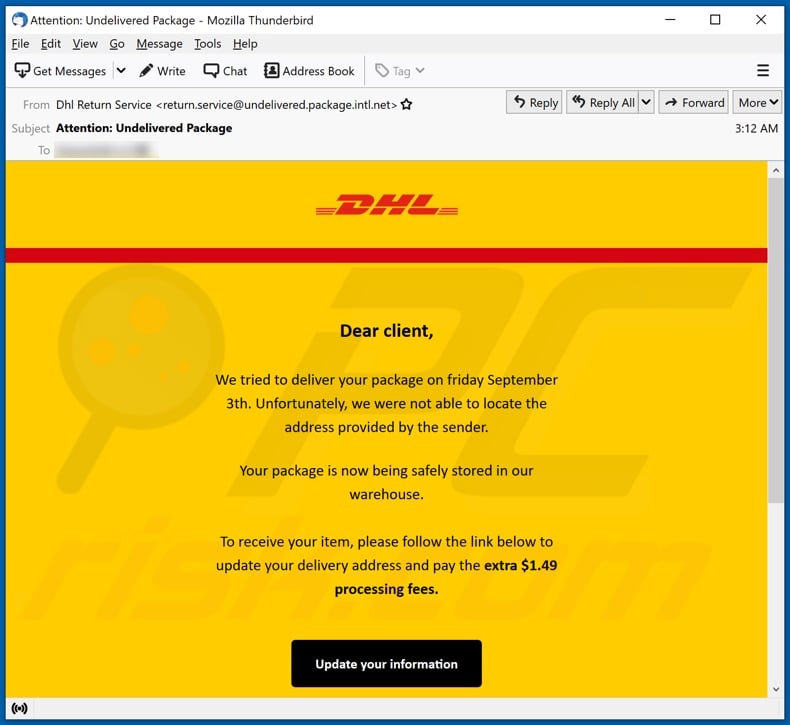
"DHL Undelivered Package email scam" in detail
The "DHL Undelivered Package" scam emails claim that "DHL" was supposedly unable to deliver a package due to problems with the provided address. Therefore, recipients are requested to provide a viable address and pay the processing fees. As mentioned in the introduction, these letters are fake. Hence, all of the information provided by them is false.
Typically, such spam emails operate as phishing scams, i.e., by tricking users into disclosing sensitive information (e.g., online account usernames/passwords, personally identifiable details, finance-related data, etc.). The collected data is then monetized by being sold to third-parties (potentially, cyber criminals) and/or used to craft personalized scams.
To elaborate, stolen communication accounts (e.g., emails, social media, etc.) can be used to proliferate malware or steal the owner's identity and ask for loans from contacts. Finance-related accounts (e.g., online banking, e-commerce, etc.) can be used for fraudulent transactions and/or online purchases.
What is more, some letters like "DHL Undelivered Package" promote scam pages that request users to make bogus payments (e.g., for shipping, storage, subscription, etc.). Scammers often ask the transactions to be made via dubious payment gateways, which record banking account details and credit card numbers entered into them.
In summary, by trusting the "DHL Undelivered Package" scam emails, users can experience serious privacy issues, financial losses, and even identity theft.
| Name | DHL Undelivered Package Email Scam |
| Threat Type | Phishing, Scam, Social Engineering, Fraud |
| Fake Claim | Scam emails claim a package was undelivered due to address-related issues, which need to be fixed and a processing fee paid. |
| Disguise | Scam emails are disguised as letters from DHL. |
| Related Domains | larayniere[.]com, rayaneguedesadvocacia[.]com |
| Detection Names (larayniere[.]com) | N/A (VirusTotal) |
| Serving IP Address (larayniere[.]com) | 213.186.33.2 |
| Symptoms | Unauthorized online purchases, changed online account passwords, identity theft, illegal access of the computer. |
| Distribution methods | Deceptive emails, rogue online pop-up ads, search engine poisoning techniques, misspelled domains. |
| Damage | Loss of sensitive private information, monetary loss, identity theft. |
| Malware Removal (Windows) |
To eliminate possible malware infections, scan your computer with legitimate antivirus software. Our security researchers recommend using Combo Cleaner. Download Combo CleanerTo use full-featured product, you have to purchase a license for Combo Cleaner. 7 days free trial available. Combo Cleaner is owned and operated by RCS LT, the parent company of PCRisk.com. |
Spam campaigns in general
"This Is The Last Reminder", "Outlook Email Quota", "I Am A Programmer And Hacked Your Computer 3 Months Ago", and "SF Express Email Scam" are a couple examples of spam campaigns. These letters are usually presented as "official", "urgent", and similar.
Aside from phishing and other scams, deceptive emails can also spread malware (e.g., trojans, ransomware, etc.). Therefore, it is strongly advised to exercise caution with incoming emails and messages.
How do spam campaigns infect computers?
Malware is proliferated via infectious files, which can be attached to and/or linked inside the spam emails. These files can be in various formats, e.g., PDF and Microsoft Office documents, archives (ZIP, RAR, etc.), executables (.exe, .run, etc.), JavaScript, and so on. Virulent files trigger malware download/installation - when they are opened.
For example, Microsoft Office documents infect systems by executing malicious macro commands. This process begins the moment a document is opened in Microsoft Office versions released before 2010. Later versions have "Protected View" mode, which prevents immediate macro execution; instead, users can manually enable macro commands (i.e., editing/content).
How to avoid installation of malware?
Suspicious and irrelevant emails must not be opened, especially any attachments or links present in them. It is recommended to only use Microsoft Office versions released after 2010.
Aside from spam campaigns, malware is also distributed via dubious download channels, e.g., unofficial and freeware sites, Peer-to-Peer sharing networks, etc.), illegal activation tools ("cracks"), and fake updates. Therefore, it is advised to only download from official/verified sources and activate/update programs with tools provided by genuine developers.
It is paramount to have a dependable anti-virus installed and kept updated. This software has to be used to run regular system scans to and remove detected threats. If you've already opened malicious attachments, we recommend running a scan with Combo Cleaner Antivirus for Windows to automatically eliminate infiltrated malware.
Text presented in the "DHL Undelivered Package" scam email letter:
Subject: Attention: Undelivered Package
DHL
Dear client,
We tried to deliver your package on friday September 3th. Unfortunately, we were not able to locate the address provided by the sender.
Your package is now being safely stored in our warehouse.
To receive your item, please follow the link below to update your delivery address and pay the extra $1.49 processing fees.
Update your information
2021 © - all rights reserved
74399 Broadway, New York, NY 13498
Unsubscribe here
Appearance of the "DHL Undelivered Package" scam email (GIF):
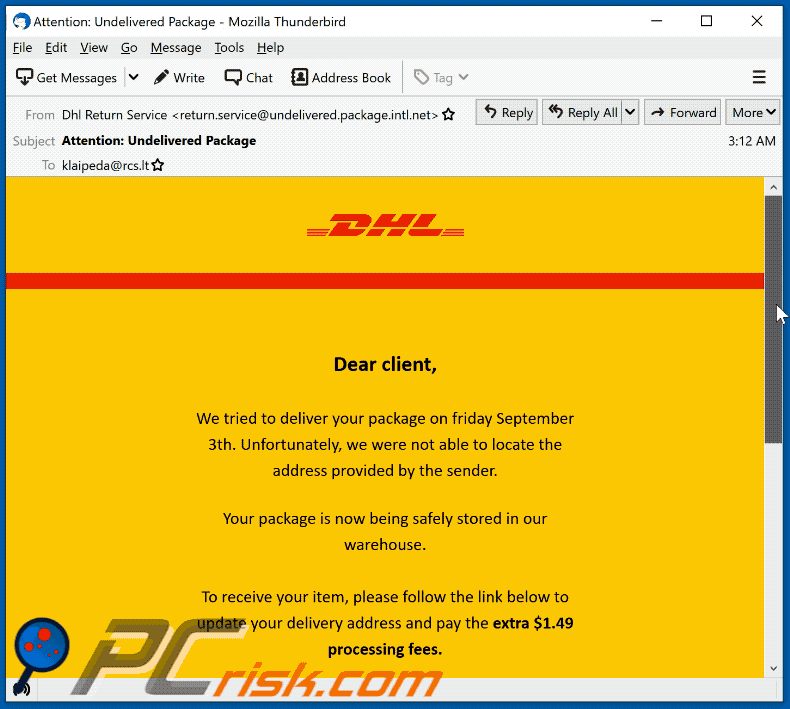
Screenshot of the website promoted by the "DHL Undelivered Package" spam campaign:
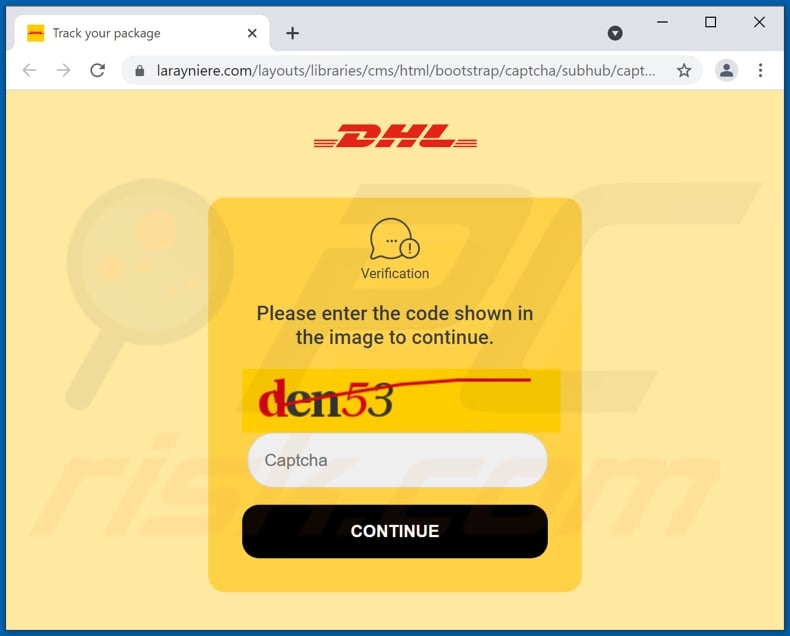
A Czech variant of DHL undelivered package-themed spam email promoting a phishing site:
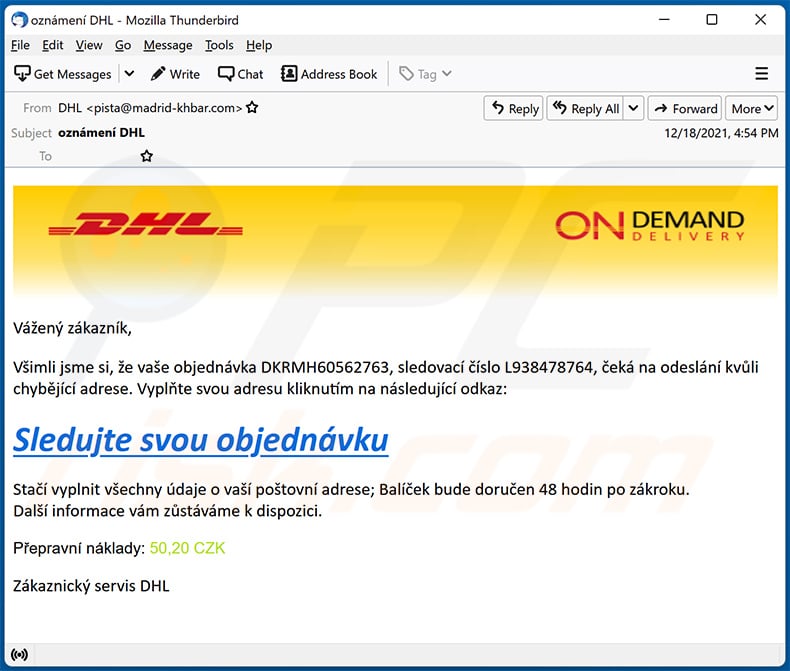
Text presented within:
Subject: oznámení DHL
DHL
ON DEMAND DELIVERYVážený zákazník,
Všimli jsme si, že vaše objednávka DKRMH60562763, sledovací číslo L938478764, čeká na odeslání kvůli chybějící adrese. Vyplňte svou adresu kliknutím na následující odkaz:
Sledujte svou objednávku
Stačí vyplnit všechny údaje o vaší poštovní adrese; Balíček bude doručen 48 hodin po zákroku.
Další informace vám zůstáváme k dispozici.Přepravní náklady: 50,20 CZK
Zákaznický servis DHL
Screenshot of the promoted phishing site:
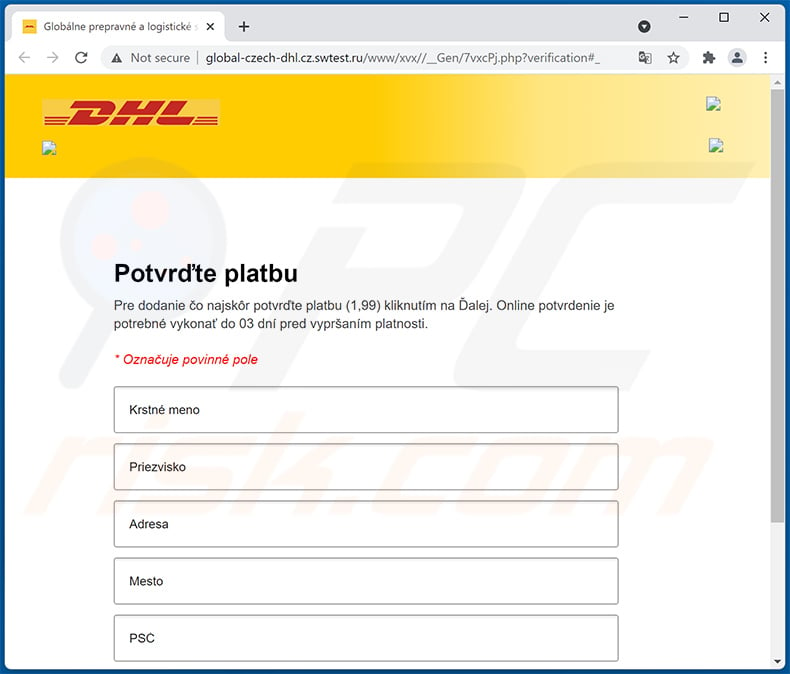
Yet another example of undelivered DHL package-themed spam email spreading Agent Tesla:
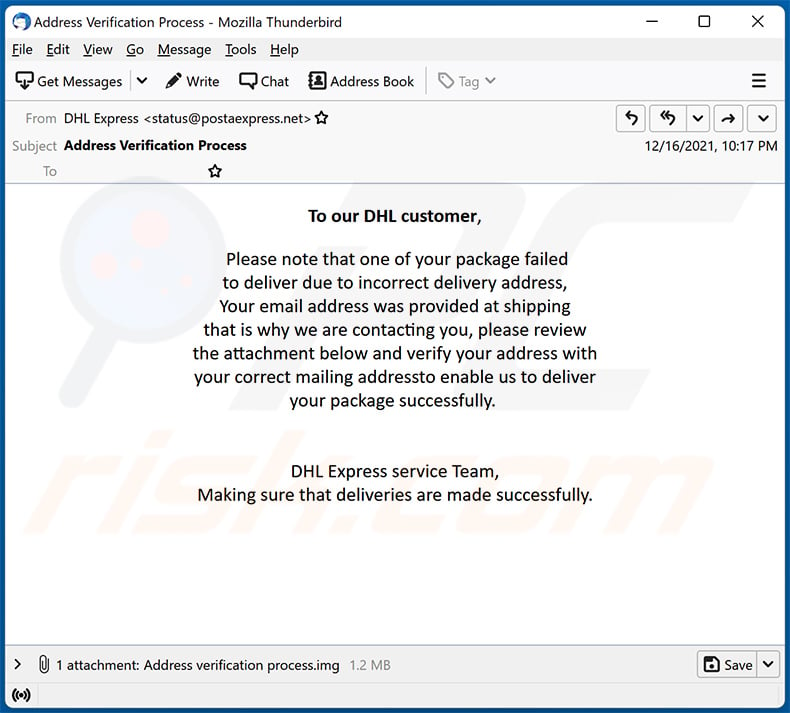
Additional example of unsuccessful DHL delivery-themed spam email promoting a phishing site:
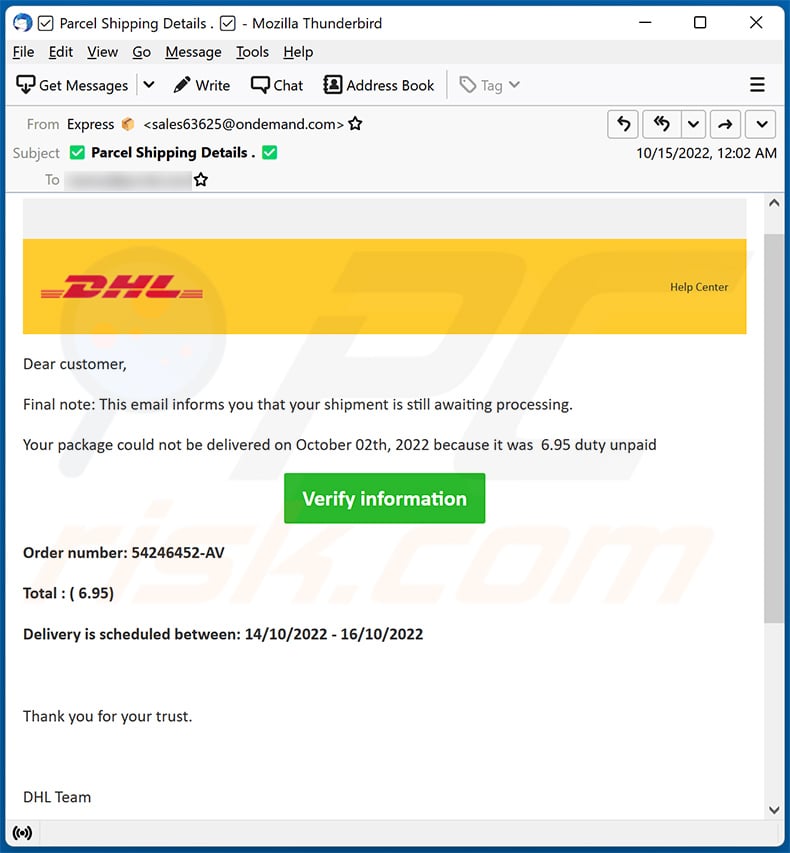
Text presented within:
Subject: Parcel Shipping Details .
Dear customer,
Final note: This email informs you that your shipment is still awaiting processing.
Your package could not be delivered on October 02th, 2022 because it was 6.95 duty unpaid
Verify informationOrder number: 54246452-AV
Total : ( 6.95)
Delivery is scheduled between: 14/10/2022 - 16/10/2022
Thank you for your trust.
DHL Team
Screenshot of the promoted phishing site:
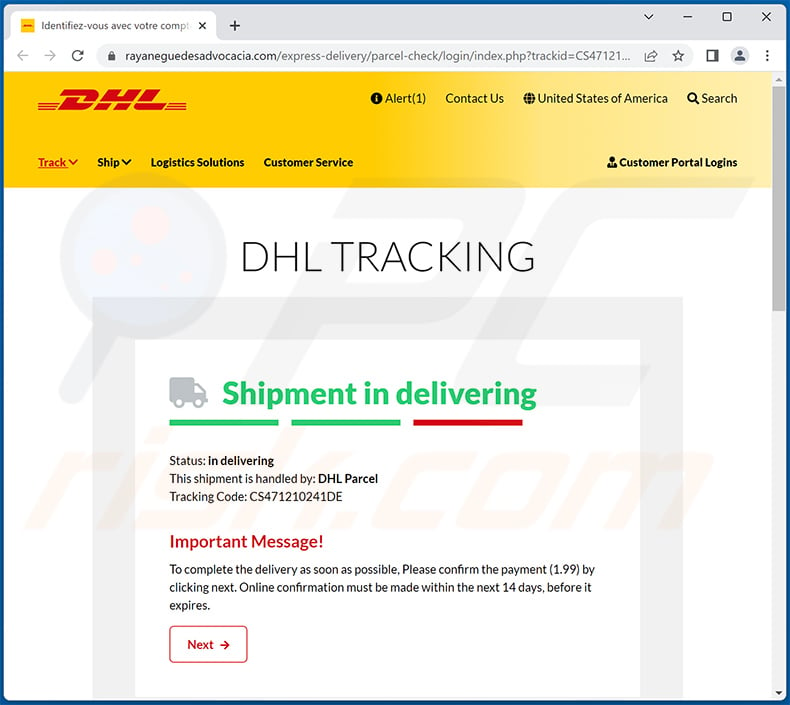
A German variant of DHL undelivered package-themed spam email:
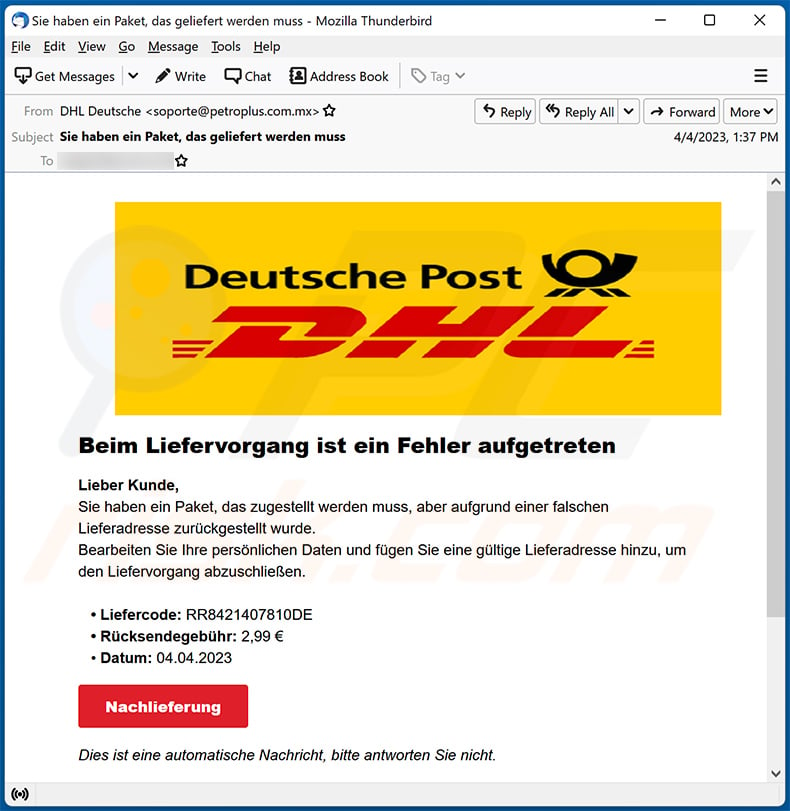
Text presented within:
Subject: Sie haben ein Paket, das geliefert werden muss
Deutsche Post
DHL
Deutsche Post DHL Group - Nomentia Case Study
Beim Liefervorgang ist ein Fehler aufgetreten
Lieber Kunde,
Sie haben ein Paket, das zugestellt werden muss, aber aufgrund einer falschen Lieferadresse zurückgestellt wurde.
Bearbeiten Sie Ihre persönlichen Daten und fügen Sie eine gültige Lieferadresse hinzu, um den Liefervorgang abzuschließen.Liefercode: RR8421407810DE
Rücksendegebühr: 2,99 €
Datum: 04.04.2023
Nachlieferung
Dies ist eine automatische Nachricht, bitte antworten Sie nicht.
Achtung: Wenn Sie Ihre Daten nicht innerhalb von 3 Tagen nach Erhalt dieser Nachricht aktualisieren und eine gültige Lieferadresse hinzufügen, senden wir dieses Paket an Sie zurück.
Danke für dein Vertrauen,
Deutsche Post DHL Group
© 2023 Deutsche Post DHL Group
Instant automatic malware removal:
Manual threat removal might be a lengthy and complicated process that requires advanced IT skills. Combo Cleaner is a professional automatic malware removal tool that is recommended to get rid of malware. Download it by clicking the button below:
DOWNLOAD Combo CleanerBy downloading any software listed on this website you agree to our Privacy Policy and Terms of Use. To use full-featured product, you have to purchase a license for Combo Cleaner. 7 days free trial available. Combo Cleaner is owned and operated by RCS LT, the parent company of PCRisk.com.
Quick menu:
- What is DHL Undelivered Package spam?
- Types of malicious emails.
- How to spot a malicious email?
- What to do if you fell for an email scam?
Types of malicious emails:
![]() Phishing Emails
Phishing Emails
Most commonly, cybercriminals use deceptive emails to trick Internet users into giving away their sensitive private information, for example, login information for various online services, email accounts, or online banking information.
Such attacks are called phishing. In a phishing attack, cybercriminals usually send an email message with some popular service logo (for example, Microsoft, DHL, Amazon, Netflix), create urgency (wrong shipping address, expired password, etc.), and place a link which they hope their potential victims will click on.
After clicking the link presented in such email message, victims are redirected to a fake website that looks identical or extremely similar to the original one. Victims are then asked to enter their password, credit card details, or some other information that gets stolen by cybercriminals.
![]() Emails with Malicious Attachments
Emails with Malicious Attachments
Another popular attack vector is email spam with malicious attachments that infect users' computers with malware. Malicious attachments usually carry trojans that are capable of stealing passwords, banking information, and other sensitive information.
In such attacks, cybercriminals' main goal is to trick their potential victims into opening an infected email attachment. To achieve this goal, email messages usually talk about recently received invoices, faxes, or voice messages.
If a potential victim falls for the lure and opens the attachment, their computers get infected, and cybercriminals can collect a lot of sensitive information.
While it's a more complicated method to steal personal information (spam filters and antivirus programs usually detect such attempts), if successful, cybercriminals can get a much wider array of data and can collect information for a long period of time.
![]() Sextortion Emails
Sextortion Emails
This is a type of phishing. In this case, users receive an email claiming that a cybercriminal could access the webcam of the potential victim and has a video recording of one's masturbation.
To get rid of the video, victims are asked to pay a ransom (usually using Bitcoin or another cryptocurrency). Nevertheless, all of these claims are false - users who receive such emails should ignore and delete them.
How to spot a malicious email?
While cyber criminals try to make their lure emails look trustworthy, here are some things that you should look for when trying to spot a phishing email:
- Check the sender's ("from") email address: Hover your mouse over the "from" address and check if it's legitimate. For example, if you received an email from Microsoft, be sure to check if the email address is @microsoft.com and not something suspicious like @m1crosoft.com, @microsfot.com, @account-security-noreply.com, etc.
- Check for generic greetings: If the greeting in the email is "Dear user", "Dear @youremail.com", "Dear valued customer", this should raise suspiciousness. Most commonly, companies call you by your name. Lack of this information could signal a phishing attempt.
- Check the links in the email: Hover your mouse over the link presented in the email, if the link that appears seems suspicious, don't click it. For example, if you received an email from Microsoft and the link in the email shows that it will go to firebasestorage.googleapis.com/v0... you shouldn't trust it. It's best not to click any links in the emails but to visit the company website that sent you the email in the first place.
- Don't blindly trust email attachments: Most commonly, legitimate companies will ask you to log in to their website and to view any documents there; if you received an email with an attachment, it's a good idea to scan it with an antivirus application. Infected email attachments are a common attack vector used by cybercriminals.
To minimise the risk of opening phishing and malicious emails we recommend using Combo Cleaner Antivirus for Windows.
Example of a spam email:

What to do if you fell for an email scam?
- If you clicked on a link in a phishing email and entered your password - be sure to change your password as soon as possible. Usually, cybercriminals collect stolen credentials and then sell them to other groups that use them for malicious purposes. If you change your password in a timely manner, there's a chance that criminals won't have enough time to do any damage.
- If you entered your credit card information - contact your bank as soon as possible and explain the situation. There's a good chance that you will need to cancel your compromised credit card and get a new one.
- If you see any signs of identity theft - you should immediately contact the Federal Trade Commission. This institution will collect information about your situation and create a personal recovery plan.
- If you opened a malicious attachment - your computer is probably infected, you should scan it with a reputable antivirus application. For this purpose, we recommend using Combo Cleaner Antivirus for Windows.
- Help other Internet users - report phishing emails to Anti-Phishing Working Group, FBI’s Internet Crime Complaint Center, National Fraud Information Center and U.S. Department of Justice.
Frequently Asked Questions (FAQ)
Why did I receive this email?
Spam emails are never personal. Scammers and cyber criminals send them in mass-scale campaigns - with the hope that some recipients will fall for them.
I have provided my personal information when tricked by a spam email, what should I do?
If you've disclosed account credentials, immediately change all passwords and contact the official support of potentially compromised accounts. If you've provided other sensitive information (e.g., ID card details, credit card numbers, etc.) - contact the relevant authorities without delay.
I have read a spam email but didn't open the attachment, is my computer infected?
Spam emails infect systems through malicious attachments or links present in them. Therefore, by simply opening and reading a scam email - you have not triggered malware download/installation.
I have downloaded and opened a file attached to a spam email, is my computer infected?
Whether a system infection occurred - depends on what format the attached file was. If it was an executable - most likely, yes. However, you may have avoided an infection - if it was a document (e.g., .pdf, .doc, etc.), as such files often require additional actions to initiate malware download/installation.
Will Combo Cleaner remove malware infections present in email attachments?
Yes, Combo Cleaner is able to detect and eliminate most known malware infections. However, running a full system scan is crucial - since high-end malware typically hides deep within the system.
Share:

Tomas Meskauskas
Expert security researcher, professional malware analyst
I am passionate about computer security and technology. I have an experience of over 10 years working in various companies related to computer technical issue solving and Internet security. I have been working as an author and editor for pcrisk.com since 2010. Follow me on Twitter and LinkedIn to stay informed about the latest online security threats.
PCrisk security portal is brought by a company RCS LT.
Joined forces of security researchers help educate computer users about the latest online security threats. More information about the company RCS LT.
Our malware removal guides are free. However, if you want to support us you can send us a donation.
DonatePCrisk security portal is brought by a company RCS LT.
Joined forces of security researchers help educate computer users about the latest online security threats. More information about the company RCS LT.
Our malware removal guides are free. However, if you want to support us you can send us a donation.
Donate
▼ Show Discussion